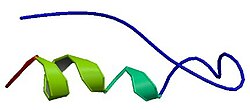Peptide YY
| Peptide YY | ||
|---|---|---|

|
||
| Mass / length primary structure | 36 amino acids , 4309.81 g / mol | |
| Identifier | ||
| External IDs |
|
|
| Occurrence | ||
| Parent taxon | Mammals | |
Peptide YY (PYY) is a peptide hormone that consists of 36 amino acids . It has the molecular formula C 194 H 295 N 55 O 57 . In humans it is found in the endocrine cells of the distal small intestine (predominantly in the ileum ) and released there. The release of PYY is mainly induced by fats . It was first found in 1980 in the mucosa of a pig's small intestine .
It is structurally related to Pancreatic polypeptide (PP) and the neuropeptide Y . With PP it has 18 amino acids in the same place.
Primary structure
Tyr - Pro - Ile - Lys -Pro- Glu - Ala -Pro- Gly -Glu- Asp -Ala- Ser -Pro-Glu-Glu- Leu - Asn -Arg-Tyr-Tyr-Ala-Ser-Leu-Arg- His -Tyr-Leu-Asn-Leu- Val - Thr -Arg- Gln -Arg-Tyr- NH 2
genetics
In humans, the peptide is on the long arm of chromosome 17 (17q21) and is therefore in the immediate vicinity of the pancreatic hormone .
physiology
The synthesis of the peptide YY takes place in specific polarized, endocrine cells of the mucous membrane. These cells usually have a triangular structure. They carry microvilli on the narrow cell side oriented towards the intestinal lumen and have basal storage vesicles (oriented towards the blood side) with the preformed hormones. In addition, depending on the species, PYY is formed in the α and / or PP cells of the islets of Langerhans in the pancreas .
The peptide YY occurs in two forms; on the one hand peptide YY1-36, on the other hand, far more frequently, peptide YY3-36. The latter is essential for the physiological effect and is enzymatically from peptide YY1-36 synthesized . Together with glucagon -type peptides and oxyntomodulin is peptide YY given postprandial (after eating) of neuroendocrine L-cells of the intestinal mucosa into the blood. The biological effects of PYY include the inhibition of gastric emptying, exocrine pancreatic secretion and gastric secretion. The aim is to delay the emptying of fatty food into the small intestine, thus enabling better digestion. The effect is mediated by activating the neuropeptide YY 2 receptor.
Peptide YY also has a strong influence on appetite and satiety and is the most powerful of all gastrointestinal hormones. It thus leads to a reduced food intake. It also has an effect on the motility of the intestine and causes the blood vessels to constrict. High PYY levels lead to an increased synthesis of FSH and LH in the pituitary gland . It can be assumed that PYY has a positive effect on the cycle.
Medical importance
In obese patients, the PYY concentration is greatly reduced, while it is greatly increased in diseases that are associated with severe weight loss. The administration of peptide YY3-36 leads to a decrease in the feeling of hunger and food consumption, although nausea occurs as a side effect.
Individual evidence
- ^ JR Siewert, Volker Schumpelick, Matthias Rothmund (eds.): Practice of visceral surgery: Gastroenterological surgery . 2nd Edition. Springer Verlag, 2009, ISBN 978-3-540-29040-7 , pp. 92 .
- ↑ a b c Entry on peptide YY. In: Römpp Online . Georg Thieme Verlag, accessed on July 17, 2014.
- ↑ Bernhard Kleine, Winfried Rossmanith: Hormone and hormone system - textbook of endocrinology . 3rd, completely revised and expanded edition. Springer Spectrum, Berlin / Heidelberg 2014, ISBN 978-3-642-37091-5 , p. 117 .
- ^ Gertrud Rehner, Hannelore Daniel: Biochemistry of nutrition . 3. Edition. Springer Verlag, 2010, ISBN 978-3-8274-2041-1 , pp. 308 .
- ^ RS Heller: The comparative anatomy of islets. In: Advances in Experimental Medicine and Biology . Volume 654, 2010, pp. 21-37, ISSN 0065-2598 . doi : 10.1007 / 978-90-481-3271-3_2 . PMID 20217492 . (Review).
- ↑ Burkhard Rodeck, Klaus-Peter Zimmer: Pediatric gastroenterology, hepatology and nutrition . Springer Verlag, 2008, ISBN 978-3-540-73968-5 , pp. 529 .
- ↑ W. Würfel: The pancreas and its importance for fertility In: Journal for gynäkologische Endokrinologie. (Austria) 2010; 20 (2)